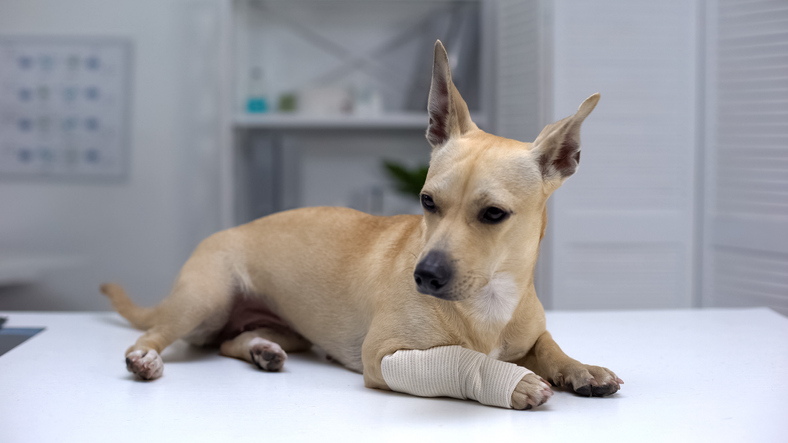No one likes the idea of their furry best friend experiencing chronic pain. That’s why an osteoarthritis diagnosis is devastating for any pet owner.
Although there is no cure, if your cat or dog has been diagnosed with osteoarthritis, your vet can recommend plenty of treatment options to help alleviate that pain, especially if the disease is caught early in your pet’s life. Find out more about osteoarthritis by reading our Huntington, NY, animal hospital‘s article below.
What is Osteoarthritis?
Osteoarthritis, also known as degenerative joint disease (DJD), is a progressive and irreversible condition of the joints that results in inflammation. It isn’t definitively known what causes the initiation of osteoarthritis, but the most common understandings of it have to do with previous injury and genetic predispositions to other conditions like elbow and hip dysplasia (abnormal development of joints) and osteochondrosis (abnormal bone growth).
While osteoarthritis is thought to be just as common in cats as it is in dogs, the disease’s physical signs can differ depending on the type of animal. For example, lameness is an evident indication of osteoarthritis in dogs but not so much in cats. In cats, the evidence is seen more in behavioral changes (becoming less active, less interested in grooming, hiding, etc.). So, whether you’re a dog or cat owner (or both), it’s important to know what you should be looking out for in terms of signs that your animal is in pain.
Treatment Options
Osteoarthritis treatment aims to alleviate pain, prevent further degeneration of the joint, and restore joint functionality.
Weight Loss Management and Dieting
One of the first things your vet will probably tell you to do is monitor your pet’s weight.
For dogs, whether they are overweight or not, low-impact exercise (like walking or swimming) will be recommended. Perhaps for weight loss, but also because the movement can aid in improving joint mobility and muscle mass, all of which can help reduce the symptoms of osteoarthritis.
Exercise is not so easily accomplished by cats, so you likely need to develop a diet that involves scheduled feedings, not just leaving food out to let your pet graze all day.
Diets containing omega-3 fatty acids and fish oil have also been proven to help some animals alleviate pain associated with arthritis.
Medications and Supplements
Chondroprotective agents (made of polysulfated glycosaminoglycan [PSGAG], glucosamine, and chondroitin sulfate) are anti-inflammatory joint agents that can be given to animals who suffer from osteoarthritis. Unfortunately, there is little success rate with this type of therapy for a number of reasons (lack of remaining cartilage, unresponsive inflammation, etc.). Alternatively, PSGAG injections can be given, but that is a more expensive treatment than oral supplements. But if you choose to go that route and your vet doesn’t see any improvement in your pet’s condition within a month or so, a different treatment will likely need to be tried.
Nonsteroidal anti-inflammatory drugs (NSAIDs) are important in the treatment of dogs with osteoarthritis, but they come with a handful of side effects (relating to the stomach, liver, and kidneys), and there are only a few drugs of this category that are safe for cats to take.
A range of narcotics are also commonly prescribed for animals suffering from osteoarthritis, but studies have shown that they have little effect on easing pain associated with the disease.
There are other medications and supplements, such as tramadol, cannabinoids, gabapentin, amantadine, vitamin E, green-lipped mussel supplements, and zoledronic acid, may be prescribed or recommended by vets for pain relief.
Surgery
If your vet has exhausted the list of available medications and success has been minimal, or if your pet is suffering from a particular underlying cause of arthritis, surgery may be recommended. The procedures that will be considered include:
- Reconstructive procedures to promote joint stability and correct anatomic defects
- Hip replacements
- Joint fusions
Alternative Therapy
In conjunction with or in lieu of any other treatments, there are many other types of therapies to consider. They include:
- Acupuncture
- Physical therapy
- Antibody therapy
- Rehabilitation therapy
- Radial shock wave therapy
- Pulsed signal therapy
- Stem cell therapy
- Platelet-rich therapy
- Conditioned plasma therapy
Additionally, studies have shown that laser (non-invasive photobiomodulation) effectively treats osteoarthritis. It works by using red and infrared light to penetrate the animal’s skin and tissue. That process energizes the cells, produces collagen (a structure protein), and repairs the tissue. Then, the healing process continues by supporting vascular dilation and synthesis, which increases blood circulation in a degenerated joint. There are no known risks associated with this treatment as it actually releases natural pain-relieving hormones in your cat or dog’s body. And rest assured, the laser treatments also do not cause your pet any pain.
For patients with arthritic pain, each laser treatment session will likely only last around 10 minutes, and most owners notice visible improvements in their pets after 3-5 sessions. The goal is for the pain and inflammation to be lessened for up to 24 hours after each laser session.
Environmental Modifications and Emotional Support
Aside from all of the medical interventions and changes in diet that your vet may suggest, you will also likely be advised to change your home through the implementation of baby gates and ramps to prevent your pet from going into areas that may be dangerous. The last thing you want for your pet with OA is for them to injure themselves further. Non-slip surfaces throughout your home are also encouraged.
This is likely a given, but you also want to ensure that you and your family members are giving your companion animal lots of love, and attention. Emotions can affect pain response, so loads of attention, cognitive stimulation, and environmental enrichment can help with your dog or cat’s pain management.
Reach Out to Our Huntington, NY, Animal Hospital for Cat and Dog Osteoarthritis Diagnosis and Treatment
Our Huntington, NY, veterinarians can diagnose and treat your pet’s osteoarthritis. If you believe your cat or dog is suffering from osteoarthritis, give our animal hospital a call at (631) 271-8383





